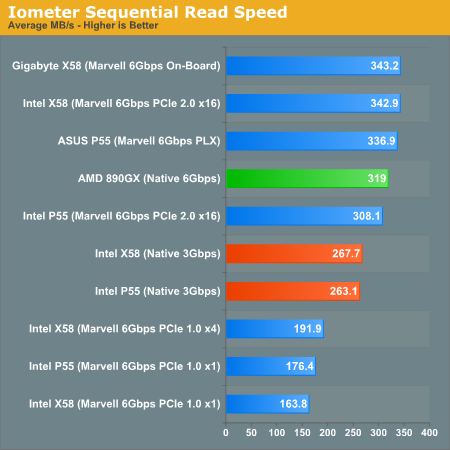6Gbps SATA Performance: AMD 890GX vs. Intel X58/P55
by Anand Lal Shimpi on March 25, 2010 12:00 AM EST- Posted in
- Storage
The First Test: Sequential Read Speed
The C300 can break 300MB/s in sequential read performance so it’s the perfect test for 6Gbps SATA bandwidth.

Intel’s X58 is actually the best platform here, delivering over 340MB/s from the C300 itself. If anything, we’re bound by the Marvell controller or the C300 itself in this case. AMD’s 890GX follows next at 319MB/s. It’s faster than 3Gbps SATA for sure, but just not quite as fast as the Marvell controller on an Intel X58.
The most surprising is that using the Marvell controller on Intel’s P55 platform, even in a PCIe 2.0 x16 slot, only delivers 308MB/s of read bandwidth. The PCIe controller is on the CPU die and should theoretically be lower latency than anything the X58 can muster, but for whatever reason it actually delivers lower bandwidth than the off-die X58 PCIe controller. This is true regardless of whether we use Lynnfield or Clarkdale in the motherboard, or if we’re using a P55, H55 or H57 motherboard. All platform/CPU combinations result in performance right around 310MB/s - a good 30MB/s slower than the X58. Remember that this is Intel’s first on-die PCIe implementation. It’s possible that performance is lower in order to first ensure compatibility. We may see better performance out of Sandy Bridge in 2011.
Using any of the PCIe 1.0 slots delivers absolutely horrid performance. Thanks to encoding and bus overhead, the most we can get out of PCIe 1.0 slot is ~192MB/s with our setup. Intel’s X58 board has a PCIe 1.0 x4 that appears to give us better performance than any other 1.0 slot for some reason despite us only using 1 lane on it.
Using one of the x1 slots on a P55 motherboard limits us to a disappointing 163.8MB/s. In other words, there’s no benefit to even having a 6Gbps drive here. ASUS PLX implementation however fixes that right up - at 336.9MB/s it’s within earshot of Intel’s X58.
It’s also worth noting that you’re better off using your 6Gbps SSD on one of the native 3Gbps SATA ports rather than use a 6Gbps card in a PCIe 1.0 slot. Intel’s native SATA ports read at ~265MB/s - better than the Marvell controller on any PCIe 1.0 slot.










57 Comments
View All Comments
Shadowmaster625 - Tuesday, March 30, 2010 - link
It sounds like AMD made a conscious decision to focus on maximum random write performance, even if it required sacrificing all other key performance metrics. I hope that is the case, because it is pretty sad that their 6 gbps controller is generally outperformed by a 3 gbps controller!astewart999 - Tuesday, March 30, 2010 - link
When talking performance, why are they not mentioning RAID 0. I suspect SATA3 is not capable?astewart999 - Tuesday, March 30, 2010 - link
Ignore my ignorance, I read the article then posted. Should have read the posts and ignored the article!nexox - Monday, April 5, 2010 - link
Just get a SASII (6Gbit) PCI-E HBA (LSI makes one, probably others) - plenty of speed, they generally run on a PCI-E 8x slot, and you can run SATA drives in them just fine. Plus they tend not to cost too much more than the consumer-level SATA adaptors, which are apparently questionable performance-wise. They'd at least make a good baseline for comparison.supremelaw - Saturday, April 17, 2010 - link
RS2BL040 and RS2BL080 are now at Newegg:http://www.newegg.com/Product/Product.aspx?Item=N8...
http://www.intel.com/products/server/raid-controll...
http://www.newegg.com/Product/Product.aspx?Item=N8...
http://www.intel.com/products/server/raid-controll...
Before buying, confirm whether or not TRIM will work with SSDs in RAID modes.
http://www.pcper.com/comments.php?nid=8538
*** UPDATE ***
The unconfirmed bit has been confirmed as unconfirmed from Intel:
“Intel® RST 9.6 supports TRIM in AHCI and pass through modes for RAID. A bug has been submitted to change the string that indicates TRIM is supported on RAID volumes (0,1,5,10). Intel is continuing to investigate the ability of providing TRIM support for all RAID volumes in a future release”
Looks like we'll have to wait a little longer for TRIM through RAID, but there *are* other SSD-specific improvements in this new driver.
*** END UPDATE ***
MRFS
chrcoluk - Saturday, June 19, 2010 - link
Ok my thoughts.1 - you written of pcie v1 however failed to notice or mention that the plx chip uses pci-e 1x lanes from the p55 chipset so clearly pci-e 1.0 can supply the bandwidth if utilised properly, the plx chip transfers 4 1.0 lanes into 2 virtual 2.0 lanes for the sata6g and usb3.
2 - some p55 boards, mine noticebly have a pci 2.0 slot fed of the p55 chipset @ x4 speed. Seems reviewers have got something wrong or are they claiming asus have it wrong? Even if we assume its actually pci 1.0 x4 that is still enough bandwidth to feed a sata 6g controller. Indeed the onboard plx which you praised sacrifices this x4 pci-e slot and uses those 4 lanes to feed itself. My thoery is the U3S6 card asus sell will perform the same as the onboard plx in a x4 slot but no reviewer has tested this properly.
3 - whats the reason you did not test both gigabytes onboard and the lower asus onboard which borrow bandwidth from the primary pci-e x16 lanes, I am looking for tests of those in both turbo/levelup and normal mode.
gimespace - Tuesday, August 8, 2017 - link
Try enabling DirectGMA with maximum GPU Aperture in Amd catalyst control center. It does not only make the graphics card faster but allowed me to get up to the maximum 560mb/s read speed for my ssd!